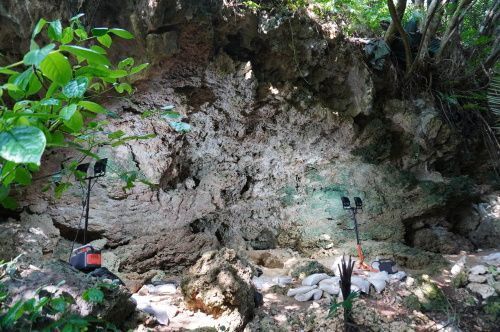Amami’s oldest rock shelter tomb identified as 11-12th-century sakudamata, age determined by remains discovered there

The sakumadata tomb cluster’s tomb no. 7 in Otsukan, China, Kagoshina China mayor Rikio Imai pointing to the place where the human remains were found – March 29
April 24, 2021 Ryukyu Shimpo
By Yukari Miyazawa
Okinoerabujima – The sakumadata tomb cluster’s tomb no. 7 ruins, which was discovered in Otsukan in China, Kagoshima in June last year, was confirmed to be the oldest rock-shelter tomb found in the Amami islands to date.
An archeological dig was conducted on the site by the China Board of Education last November, and fragments of Kamuiyaki pottery (earthenware made in Tokunoshima from the 11th to 14th century) were discovered along with over 30 human bones and teeth. Three of these were tested to have their age determined, and it was confirmed that one of them came from the 11-12th century.
It was hypothesized that the Kamuiyaki pottery, based on its shape, was an 11-12th century burial accessory that had been entombed with the deceased, and the dating of the remains places the bones and the pottery fragments in the same time frame. It provides evidence that the sakumadata tomb cluster’s tomb no. 7 was used as a burial site from the 11th to 12th century.
On March 29, China mayor Rikio Imai spoke with the press at the burial site, commenting, “The ruins are valuable for research on the evolution of burial sites in the Ryukyu Islands. We want to continue with excavation while opening the site for public viewing.”
(English translation by T&CT and Sam Grieb)
Previous Article:Gushiken says collecting soil from former battlefield is a “huge mistake” in MOD/MHLW meeting
Next Article:Tarama traditional ceremony “Upuri” for sinking insect pests into the sea in prayer for a bountiful harves
[Similar Articles]
- 9,000-10,000-year-old bone fragments discovered in Okinawa thought to be missing link between Paleolithic and Kaizuka-era humans
- Human bones dating back 9,000 years found at Sakitari Cave
- Human bones and stone tools dating back 12000 years found in Nanjo
- 24000 year-old human remains discovered at Shiraho Saonetabaru Cave Ruins in Ishigaki City
- Early 14th century castle wall discovered at Nakagusuku Castle, predating previously accepted historical timelines
 Webcam(Kokusai Street)
Webcam(Kokusai Street)


